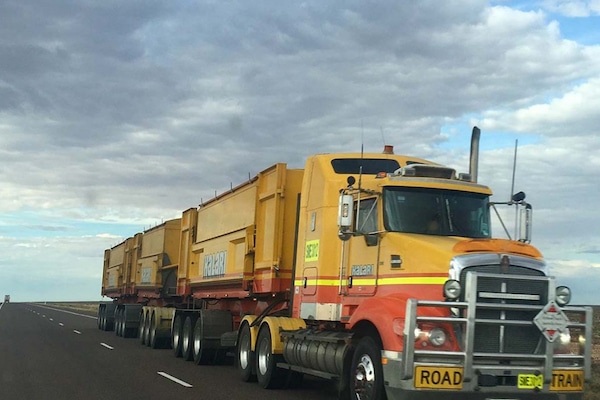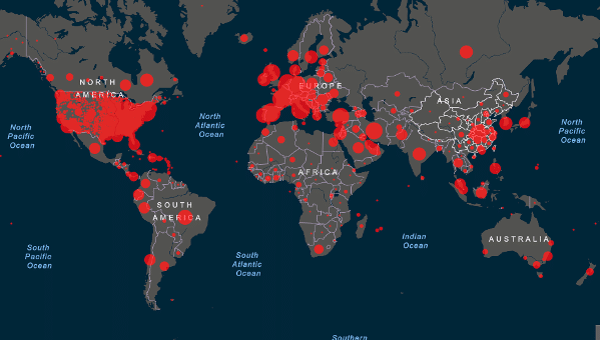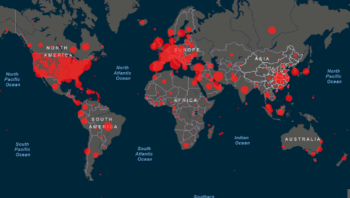
How “just-in-time” capitalism spread COVID-19
TRADE ROUTES, TRANSMISSION, AND INTERNATIONAL SOLIDARITY
Capitalism has accelerated the transmission of diseases. Historically, most epidemics have spread geographically through two common forms of human long-distance movement: trade and war. The timing, however, changed dramatically with the rise of capitalism.
In the Middle Ages, it took a decade or so for the Black Death (bubonic plague) to spread from China via the Silk Roads and Mongol conquests to Europe. Then, years to move from Sicily to Britain and beyond, via established trade routes and the movement of armies during the Hundred Years War. With capitalism well established, the “Spanish Flu” of 1918 spread in months from Spain, through France to Britain by Mid-June, and then to the U.S. and Canada in September. To a large extent, it followed the course of battle lines, troop movements, and military logistics during WWI.
In the era of just-in-time logistics, it took the coronavirus mere days to spread from Wuhan to other Chinese cities hundreds of miles away. It took only two weeks to move beyond China, simultaneously along major supply chains, trade and air travel routes to the industrial and entrepôt enclaves of East Asia, the war-torn, oil-producing Middle East, and industrial Europe, North America, and Brazil.
By March 3, it had hit 72 countries. Following major supply chain routes, it initially bypassed most of Africa and much of Latin America although now it has moved into those continents as well, with potentially even greater risk to life.
PANDEMIC TRAVELS ALONG THE CIRCUITS OF CAPITAL
As MIT logistics guru, Yossi Sheffi, pointed out in The Power of Resilience, “The growing interconnectedness of the global economy makes it increasingly prone to contagion. Contagious events, including medical and financial problems, can spread via human networks that often strongly correlate with supply chain networks.
Indeed, Dun & Bradstreet estimates that 51,000 companies around the world have one or more direct suppliers in Wuhan, while 938 of the Fortune 1000 companies have tier one or two suppliers in the Wuhan region. The emphasis for the last two or three decades on lean production, just-in-time delivery, and, more recently, “time-based competition,” along with updated transportation and distribution infrastructure, has accelerated the speed of transmission.
A Johns Hopkins expert in Italy said,
Thinking about our value chains—or the way industries produce goods—Europeans are far more integrated with one another than they often think. If one European country is severely affected, then the problem transfers very quickly to everybody else.
That explains why the tracking map from Johns Hopkins Coronavirus Resource Center, showing the concentrations of infection in the U.S., mirrors similar maps from the Brookings Institution’s studies of concentrations of manufacturing, transportation hubs, and warehousing. This is yet another indication that this virus has moved through the circuits of capital and the humans that labor in them, and not solely by random “community” transmission.
SHORT CIRCUITING SUPPLY CHAINS
The shortage of personal protection equipment (PPE) in many countries, particularly N95 respirator masks essential to safe healthcare work, is itself the result of decades of production outsourcing. Firms such as 3M, Honeywell, and Kimberley-Clark shifted production to China and other low-income countries in search of higher profits.
The Washington Post documents that “Up to 95 percent of surgical masks are made outside the continental United States, in places like China and Mexico.” As a result, one major distributer of medical equipment noted in March,
N95 Respirators’ Est. availability is April-May. Many are manufactured in China and there could be additional delays.
Not surprisingly, former Trump adviser and alt-right commentator Steve Bannon seized this opportunity to promote his xenophobic agenda. Nevertheless, the failure of the U.S., or any country, to produce medical emergency equipment within reasonable reach so outfits like 3M can boost profits is clearly both immoral and reckless.
The impact of the virus, in turn, soon took its revenge on the very routes by which it spread, disrupting production and supply chains in complex ways. By the beginning of March, 9 percent of the world’s container fleets were idle—and this percentage has certainly increased. Chinese manufacturing output was down 22 percent in February, according to a March UNCTAD report.
The same report demonstrates that the countries or regions most economically affected by disruptions in global value chains originating in China were (in order of magnitude): the EU, U.S., Japan, South Korea, Vietnam, Taiwan, and Singapore—all among the most affected by the virus in the early stages. Chinese exports dropped by 17 percent in January and February. By mid-March, the Port of Los Angeles was operating at 50 percent, and Long Beach by 25-50 percent mainly to due plant closings in China according to the Financial Times.
SQUEEZING ESSENTIAL WORKERS
Government responses in the U.S., in particular, were designed to boost the economy in the only way both neoliberal politicians and Trump Administration “experts” know: subsidizing business and reducing its costs. In addition to the well-known pro-business bias of Trump’s $2 trillion “stimulus” package, government reaction in support of capital in the U.S. has included a command for workers to stay on the job, combined with a tsunami of deregulation for business.
The Department of Homeland Security’s (DHS) (not the CDC’s) determination of who must continue to work as “essential” labor is so sweeping as to include virtually the entire labor-powered engine of capitalist profit. Inadvertently, of course, the DHS has reminded us of just how essential the entire working class is to the functioning of society in good times or bad.
This goes as well for the highest of high-tech outfits like Amazon where, we are constantly told, robots do everything. As some Amazon workers protest and about 30 percent stay at home, the company tries to hire thousands to fill the gap. As the New York Times reports,
For all of its high-tech sophistication, Amazon’s vast e-commerce business is dependent on an army of workers operating in warehouses they now fear are contaminated with the coronavirus.
To ease the “burden” (i.e. cost) of regulation on business further, the EPA has suspended all environmental regulation enforcement (despite the ongoing climate crisis), while the Federal Railroad Administration has issued an emergency waiver of numerous safety regulations. The NLRB has suspended all union representation elections including those done by mail.
The Federal Motor Carrier Safety Administration (FMCSA) granted “hours-of-service regulatory relief to commercial vehicle drivers transporting emergency relief….” This of course means longer hours on the road. The FMCSA’s list of items covered as “emergency” relief is very comprehensive, including raw materials, fuel, paper and plastic products as well as direct medical supplies. Truckers moving in and out of New York City, the epicenter of the virus in the U.S., were told to continue as usual, but to be sure to “social distance” and to wash their hands.
Despite the economic slump, which began even before the epidemic, and the fact that the first seventeen cases in the U.S. were officially counted in January, the BLS reported that as of February, non-farm payroll employment was up, and unemployment was stable. Health care, government, food services, construction, and, of course, financial services were all up, while “employment in other major industries, including mining, manufacturing, wholesale trade, retail trade, transportation and warehousing, and information, changed little over the month.” The average hours per week increased by 0.3 percent in February.
Transport Topics, the trucking managers’ journal, wrote, “As America grapples with the coronavirus and daily life is altered, the nation‘s truck drivers are among those who are risking their personal health and doing the hard work to keep products moving to stores, hospitals and elsewhere.” The American Trucking Association (ATA) reports that truck tonnage rose by 1.05 percent in January and 1.8 percent in February, meaning that, indeed, truck drivers are “risking their personal health.”
While rail freight traffic has been down for the last couple of years, the Association of American Railroads (AAR) notes that three categories of freight were up in 2020 (chemicals, food, and miscellaneous carloads) and “intermodal volumes of the railroads serving the West Coast ports that receive the bulk of imports from China appear to have plateaued over the last four weeks, indicating that we may have seen the worst of the COVID-19 impacts on the Asia trade.”
This is highly unlikely. Indeed, by March workers on the Union Pacific and Canadian Pacific freight lines had caught the virus. The U.S. Postal service reported 111 case of COVID 19, while over 300 workers in New York City’s transit system had the virus by April. A new “gig” economy is going viral as home delivery outfits like Instacart, Amazon, and Walmart hire by the thousands and rack-up big bucks from frightened home isolators.
MASS LAYOFFS, DEPRESSION-ERA UNEMPLOYMENT, AND VIRAL INEQUALITY
This picture will certainly change rapidly as global trade slows down and more and more activities are forced to slow down or halt due to illness, “social distancing,” lockdowns, and self-isolation. On the one hand, millions of workers will have no choice but to work longer hours risking infection, while millions of others face unemployment and poverty. Even more than usual, workers are damned if they do and damned if they don’t.
With a sudden drop in employment larger than that in 2008, the Economic Policy Institute estimates some 20 million jobs will be lost by July. Already, 10 million workers have applied for unemployment insurance by early April. The New York Times estimates that the unemployment rate is already 13 percent, the highest official rate since the great Depression of the 1930s. Furthermore, as economist Michael Roberts argues, this is most likely only the opening of a deeper global recession.
Nevertheless, the fact that so many will have to continue to work for private employers during the epidemic reminds us both that capital’s desire to continue to make profits depends on these workers, while the “silent compulsion of economic relations” faced by most workers who are compelled to live “from paycheck to paycheck,” is alive and well in this deadly health crisis.
Furthermore, while some like to say that the coronavirus doesn’t discriminate—after all, British Prime Minister Boris Johnson is in the ICU at time of writing—its impact is highly unequal. In virus-ravaged New York, The New York Times reports, “Nineteen of the 20 neighborhoods with the lowest percentage of positive tests have been in wealthy ZIP codes.”
As experts at the Johns Hopkins Coronavirus Resource Center explain,
While frustrating but manageable for many people the economic fallout of social distancing is brutal for the poorest, most vulnerable and marginalized members of our society.
Among the hardest hit are those at or near the bottom of the nation’s food supply chains—farmworkers and those in warehouse across the country that pick and move the nation’s mostly seasonal crops. The majority of these workers are undocumented immigrants. Ironically or cynically, they have been declared essential workers, indicating the economy’s reliance on them to remain in the workplace, where they are vulnerable to the virus.
At the same time, they are still subject to deportation. Sometimes, they are given letters from employers declaring them essential so they can travel to work, but these do not protect against deportation, especially once they cease to be essential in the eyes of the government or the season ends. It is a scandal that the U.S. has not granted legal residency to them and others in this position, as the government of Portugal has done.
CLASS STRUGGLE IN THE TIME OF PANDEMIC AND RECESSION
In the vast majority of worker protests across the world, two issues stand out: Paid Time Off (PTO) and Personal Protective Equipment (PPE), the two “Ps” of class struggle in the time of plague. The Congressional coronavirus package mandates two weeks of paid leave for those with the virus, but only for those employed by firms with fewer than 500 employees. This excludes almost half the private sector workforce, and there is no mandate for PPE.
Workers from call centers,delivery services, UPS, hospitals, railroads, and elsewhere are demanding both PTO and necessary PPE from employers who talk about safety but fail to deliver what workers need immediately.
The cross-union, rank-and-file-based Railroad Workers United has circulated a resolution demanding these essentials. A petition passed around by Teamsters for a Democratic Union won two weeks paid leave for UPS workers if they, or a member of their family, catch the virus. Starbucks workers petitioned not to be called “essential,” and to get paid leave.
Delivery, retail, and warehouse workers took the struggle for the two “P”s a step further. Striking UFCW members in Ohio grocery stores demanded paid sick leave. Teamsters at a Kroger warehouse in Memphis struck after a co-worker was diagnosed with coronavirus. Instacart workers who home deliver food struck across the U.S. for safety equipment and PTO for those with medical conditions.
Similar actions occurred at McDonald’s locations in Tampa, St. Louis, Memphis, Los Angeles, and San Jose, while Amazon workers on Staten Island walked out on Monday, March 30. Amazon finally granted its warehouse workers paid time off after workers in Chicago facilities petitioned and marched on the job for PTO.
Manufacturing workers also took action. Fifty non-union poultry workers at a Perdue Farms plant in Georgia walked out, stating they were tired of “risking our lives for chicken.” Half the workers at General Dynamics’ Bath shipyards stayed away from work when one worker caught the virus.
Fiat-Chrysler workers in Sterling Heights, Michigan and Windsor, Ontario walked out demanding their plants be closed. Auto parts makers at American Axle also stopped work to demand PTO. IUE-CWA locals have demanded not only PTE, but that General Electric switch from normal production and use idled plants to produce much needed ventilators for coronavirus victims.
Naturally, America’s militant education workers took a leading role in the fight for protection. The Chicago Teachers Union and SEIU Healthcare workers in that city joined forces to demand fifteen days paid leave and home delivery of food.
The LA teachers’ union called for “a weekly disaster stipend for parents to stay at home with their children.” New York City teachers in the Movement for Rank-and-File Educators (MORE) in the United Federation of Teachers organized a sick out and played a role in forcing the city to close the schools.
Teamster sanitation workers in Pittsburgh stopped collecting trash, demanding PPE. Canadian sanitation workers in Hamilton, Ontario stopped work, demanding PPE and that organic waste be bagged before collection. Birmingham, Alabama bus drivers refused to drive regular routes until management agreed to provide PPE, eliminate fare collection, and provide paid leave for those with the virus.
LEARNING NEW HABITS OF STRUGGLE
The spread of coronavirus has helped to reveal that today’s workplaces are linked by multiple networks. Trump tries to keep the economy going by having the DHS redefine “essential” workers as just about everyone. This makes it clear that the circuits of capital and labor connect workers around the world and across town.
Chinese makers of N95 masks connect with New York City nurses, Amazon fulfillment workers in Will County, Illinois, and with UPS drivers in Chicago. Railroad, trucking, and postal workers connect with just about everyone. Worker actions, even limited ones, can have an impact beyond the immediate workplace in today’s Just-In-Time world.
No good can be produced, no service delivered, if the things that enable these activities are not made and moved by the hand of labor. If the circuits of capital and labor helped to spread this disease, so too can worker actions along these links help to bring about a new order of class power relations in the aftermath of the epidemic.
Just as many people displayed selfless solidarity with others in this crisis, so solidarity across employer, industry, occupational, and national lines will be needed to fight for a better world in the post-pandemic era.
“Things will never be the same,” many commentators say. There will be big changes, to be sure, but unless they are driven from below by the actions of the vast majority, they are more likely to be of the “Things must change in order to stay the same” sort.(1) Companies will change shape as firms go under, mergers abound, supply chains are rationalized, workforces are cut, government funds pour into corporate coffers, and profits revive.
But they will hardly abandon management prerogatives or short-change shareholders. Conservative and liberal governments alike will spend like war-time Keynesians in order to bolster corporate bottom lines.
But will they replace the incomes lost to millions of workers? Will they enable union representation? Will they put even those already shredded environmental and safety regulations they “waived” back into force, much less prepare for the next epidemic or take real steps to head off climate catastrophe?
Unless there is a massive upsurge from below, the power relations inherent in capitalism’s social relations of production and their extension through “civil society” and government, will be reaffirmed as they were after 2008. Despite the hopes of many and the obvious differences between candidates, the money-driven politics that are the norm in the U.S. today will assure this to one degree or another no matter who wins the election in November. It will be up to those “essential” workers to create a new balance of social power and a healthy and sustainable world.
Notes:
- Sicilian aristocrat Don Fabrizio’s cynical response to Italy’s 1848-49 revolution in di Lampedusa’s The Leopard.

